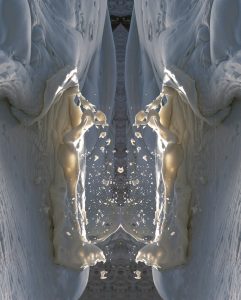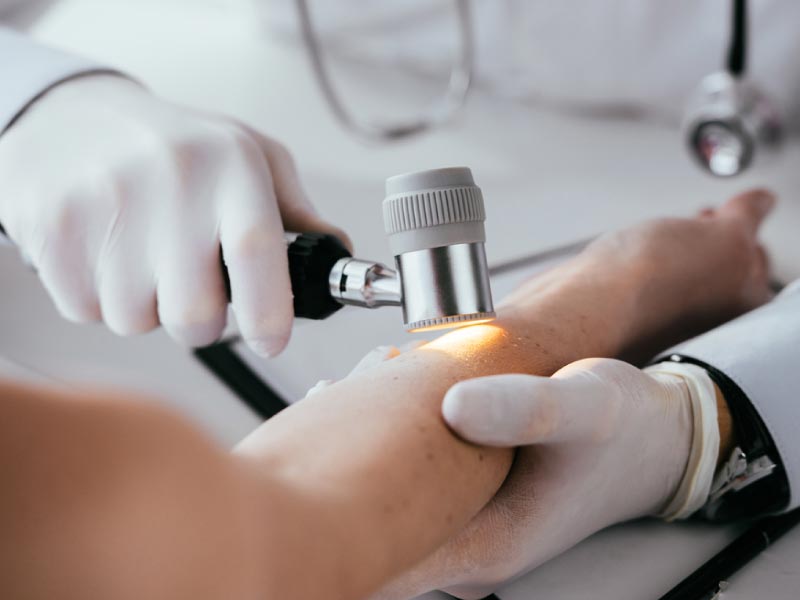Beyond the aesthetics of color
As a dermatologist, when I see color, I think about structure and depth. Red to me signifies inflammation or blood vessels. White can mean scar or scale. Additionally, the same structure in different layers of the skin can appear differently. Melanin (pigment), for example, is black when it is high in the epidermis, but appears brown in lower layers. In the dermis, it appears blue due to the way collagen scatters light. Furthermore, color is not a static phenomenon. I may see a suspicious mole on a young person’s back but be reassured by an even, brown pigment network. Six months later it may develop an ugly, off-center blue-white blotch indicating that the cells have invaded the dermis thereby heralding its transformation into melanoma.
For Icelandic artist Karen Pálsdóttir, there is a strong element of intentionality with how she thinks about color as well. In her recent monochromatic oil paintings, she chooses to explore her subjects through a cobalt blue lens. She shrouds her female posers in blue, because the color was venerated by early cultures due to its rarity in nature: the plumage of an elusive, exotic bird or the blossoming of a flower. Additionally, she starts by applying the darkest hues onto canvas and finishes with lighter colors to convey visual and symbolic depth to her portraits. Color in dermatology and in visual art is a nuanced phenomenon transcending pure aesthetics.

Karen Pálsdóttir, “Kira (Close Up)”, 2020, oil on paper, 8 x 8 in.
The part and the whole
The Spanish artist Jorge Barbi uses found objects and scenes from nature as a starting point for his work. In Espuma I (2009), he photographs sea foam during a winter storm as it interacts with light and shadow thereby taking on an entirely new form reminiscent of classical Greek sculpture. In context, the banality of an everyday occurrence takes on a new appearance and conveys the beauty in a fleeting moment and the primacy of chance. Whereas in Charca I (2007), symmetrical sea puddles formed among rocks of his native Galicia, take on an anthropomorphic form when considered in context of one another and leave the viewer with a subtle feeling of dread. Barbi’s work challenges us to consider the relationship of the part with its whole thereby imbuing the commonplace with the sublime.

Jorge Barbi, “Espuma 1”, photograph, 23 x 29 in. Ed. 7
When we biopsy a suspicious skin lesion, we rarely take the whole thing: we may seek to minimize the resulting scar on a cosmetically sensitive area or the lesion may be too large for it to be practical. Implicit is our understanding that we are sampling a dynamic process, in a single moment, and as part of a whole. There is an inherent risk of sampling error. For example, a shallow biopsy of a lesion we think is benign may reveal a more ominous carcinoma if biopsied deeper. Conversely, the bizarre appearance of the individual cells in a mole may alarm us, but the symmetrical borders of the lesion as a whole and the regular maturing of the cells as they progress deeper into the dermis reassure us of its benign nature. In dermatology as with art, context is paramount and we cannot claim to understand form or process without it.
Texture as transformation

Leticia Sampedro, “The end is the beginning”, 2019, mixed media on canvas, 36 x 48 in
In a total body skin examination, touch is arguably as important as sight. As I walk my hands over the sun exposed skin, I am feeling for subtle roughness that signifies transformation of normal cells into precancerous ones. Similarly, I can easily tell how long eczema has been there for by feeling the velvety texture associated with long-term rubbing. Scale and crust are the skin’s dynamic responses to insult or injury. The Spaniard Leticia Sampedro, informed by her background as a performance artist, uses her body as a channel, directing frenetic motion through mixed media and paint on canvas. The impastos well-characterized in Bloom (2020) challenge visual harmony and formal boundaries, and explore the concepts of balance and energy. Texture as process is a core intersection between art and dermatology.
Aesthetic choice
American artist Tiffany Wang is prominently concerned with aesthetic choices. For example, in W 23rd St (2018), she reflects on how the natural world has been pruned and manicured as a way to suit our narrow perception of beauty. The clean lines and complementary colors of the painting belie a sense of sadness as we shape the world around us. “In a reality that feels increasingly distanced from unmediated experience, I look to the natural world, and plants, in particular, as a source of enduring wisdom, beauty and resilience”, she says.

Tiffany Wang, “W23rd St”, 2018, acrylic on canvas, 12 x 12 in
Dermatology is also a field filled with aesthetic choices. We are taught to design cancer excisions along relaxed skin tension lines and to always respect anatomical boundaries to maintain the natural harmony of the face. In evaluating beauty in the aging face, we learn about the golden ratio and the so-called “triangle of beauty”. However, we increasingly recognize aesthetic medicine as being profoundly culturally informed. The diversity of human beauty does not fit neatly into narrow, historically Eurocentric constructs. Similarly, the aging face tells a story, and can be a source of beauty and resilience. The intersection of art and dermatology is the recognition that imbued in aesthetics are choices and value judgements. Intentionality is critical.

